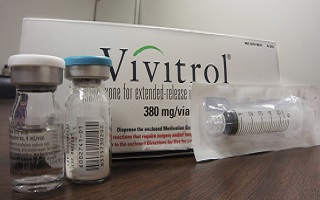Vivitrol and Overdose Risk
A new analysis of a large randomized trial finds 2.4x higher risk for overdose with naltrexone compared to buprenorphine. Methadone and buprenorphine are still the safest and most effective treatments for opioid use disorder.
Naltrexone is one of three medication-assisted treatments (MAT) for opioid dependence approved in the United States. Vivitrol, along acting formulation of naltrexone, works differently than methadone or buprenorphine. It is an antagonist – meaning that it blocks opioid receptors in the brain, preventing opioids from attaching.
Vivitrol was approved in the US based on one Russian efficacy study that compared it to placebo. When people dropped out of the trial {54%of participants did not complete the study protocol), researchers did not follow up to see if they overdosed. The usual practice when evaluating a new medication is to compare it to the standard of care (which, in thiscase, would have been methadone or buprenorphine). Because this hadn’t been done, experts were left wondering how naltrexone’s safety and effectiveness compared to those medications with a longer track record.
In 2017 experts finally received what they thought was an answer when the results of a large trial comparing naltrexone to buprenorphine were published. called X:BOT, this study found that almost double the proportion of people in theVivitrol group had overdosed, compared with the Suboxone (buprenorphine) group. However this difference wasn’ t statistically significant. Concerningly, the study also indicted that Vivitrol is a more difficult treatment to start: 28% of people randomized to receive Vivitrol did not complete induction, compared to 6% in the Suboxone group. Still, Alkermes, the maker of Vivitrol, frequently points to this study to promote their product.
In the meantime, research continued into the overdose risk associated with Vivitrol. A look at Vivitrol-related adverse events reported to the US Food and Drug Administration found that most overdoses occurred in the first 70 days since thelast dose of Vivitrol, indicating that the first 6 weeks following dissipation of the medicine’s blockade is a period of potential danger. Another study showed that people on Vivitrol are more likely to stop treatment quickly:claims data revealed that 52% of commercially insured US adults stop Vivitrol after only 30days. Another large claims data study found that only methadone and buprenorphine were associated with reductions in overdose and serious opioid-related acute care during follow-up. Neither naltrexone nor inpatient detoxification and residential services were associated with lowering overdoses or the need for acute care.
With all this concerning data about Vivitrol, researchers at UNC decided to take another look at the data collected in the landmarkX:BOT study, which was recently made publicly available through the National Institutes of Health. When they reanalyzed the data, the researchers found something surprising: the X:BOT study had missed cases of overdose. In the dataset, overdoses were captured in two different columns; the X:BOT researchers had completely overlooked one of those columns. (It is standard practice in drug safety science to lookat keywords in both columns.)
When the UNC team reanalyzed the data with these additional overdose cases, they found that the hazard of overdose was 2.4 times higher in the naltrexone group than in the buprenorphine group,a statistically significant difference. When theX:BOT researchers were presented with this information, they conceded that they had not counted these additional overdose cases.
Ajazi EM, Dasgupta N, Marshall SW, Monaco J, Howard AC, Preisser JS,Schwartz TA.
Revisiting the X: BOT Naltrcxone Clinical Trial Using a Comprehensive Survival Analysis.
Journal of Addiction Medicine.2021 Dec 3
doi: 10.1097/ADM.000000000000931


Leave A Comment